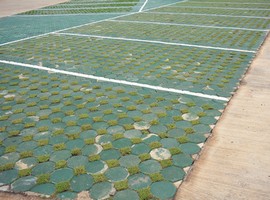Paving the way ahead
 |
There are roughly 12 million miles (18 million Km) of paved road and countless millions of square kilometers of paved carparks (parking lots), driveways, pavements (sidewalks), tennis and basketball courts, and other areas covered in tarmac in the world and since all of this area gets many hours of sunlight a day its potential for generating power is huge. The concept has been talked about for a long time, after all when the sun beats down on concrete it gets hot and causes urban heat islands. Urban heat islands (UHI) are the difference in temperature between a town or a city and their rural surroundings. They cause an increase in the length of the growing seasons; decrease the chance of weak tornadoes and a decrease in air quality and downwind of the UHI rainfall is increased.
It’s no great surprise that concrete and tarmac can be used to generate power, after all, all you have to do is touch a roof or a pavement after the sun has been beating down on it for a while to realize how hot it gets. The other benefit is that it’s slow to release the stored heat, so long after the sun has gone down energy is still being released. In 2008 researchers at MIT announced a new method of capturing this energy using asphalt as the solar collector. The researchers put heat exchangers a few centimeters below the surface of their trial paving, where it’s at its hottest and by experimenting with highly conductive aggregates such as quartzite they discovered the best way to increase heat absorption and by applying a reflection reducing paint they increased it further.
Skip forward six years and the MIT research has gone quiet, but news of a new crowd funded initiative, that began in 2004, is coming out. Solar Roadways use high impact hexagonal solar panels, capable of withstanding weights of 250,000 pounds, to gather electricity from the sun whilst also using it to power LED lights and heating elements for a wide range of applications. The use of LEDs could render painted lines a thing of the past and routes could be automatically reprogrammed for incidents. Watch the video here.
The point behind both of these ideas, is that towns and cities around the world already use the space allocated to roads and parking lots, what they don’t need to do is allocate more space for huge solar farms. These initiatives could save a lot of space and hopefully get rid of wind farms and solar farms. |